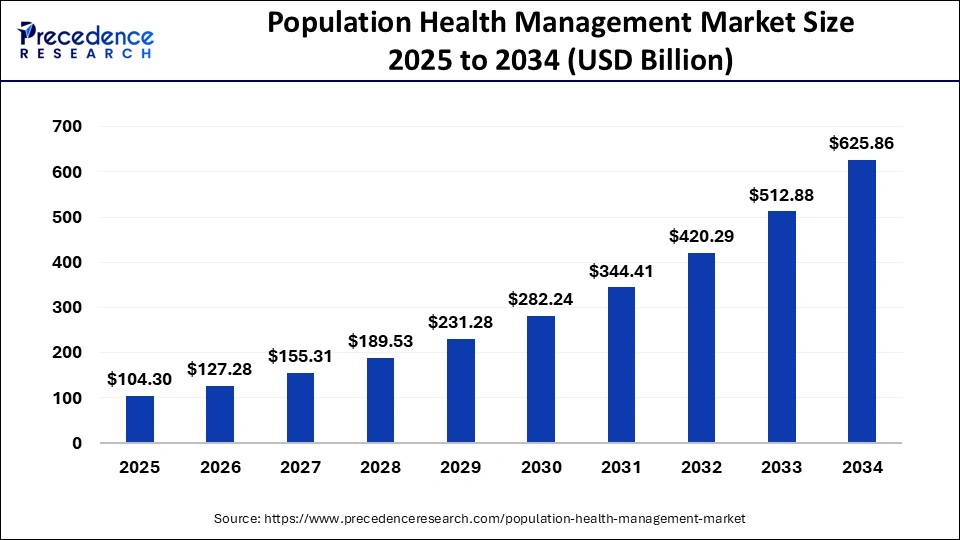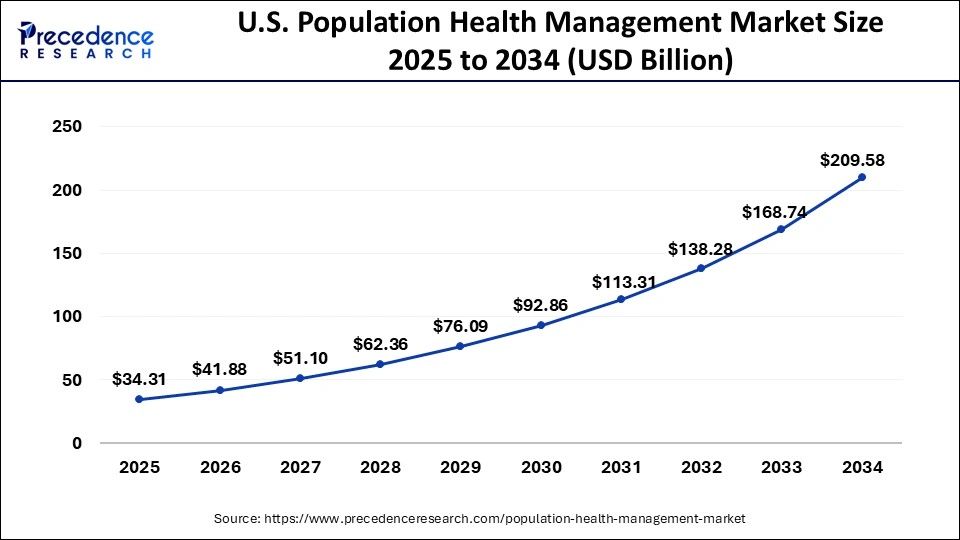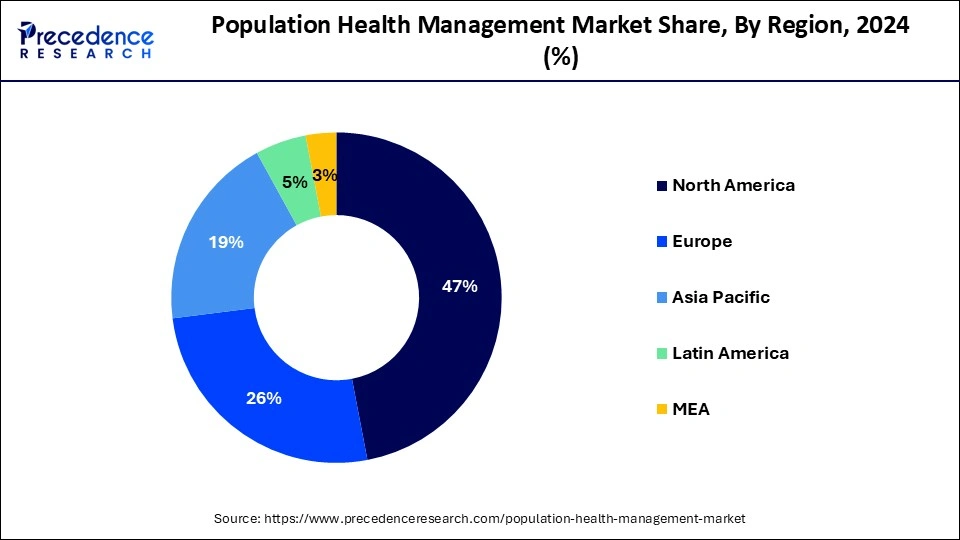List of Contents
What is Population Health Management Market Size?
The global population health management market size accounted for USD 104.30 billion in 2025 and is predicted to increase from USD 127.28 billion in 2026 to approximately USD 625.86 billion by 2034, expanding at a CAGR of 22.03% from 2025 to 2034.

Market Highlights
- North America will contribute the highest market share of 47% in 2025.
- By product, the services segment contributed the highest market share in 2025.
- The software product segment has captured a 47.4% revenue share in 2025.
- By end use, the healthcare providers segment is expected to hold the largest market share in 2025.
Market Size and Forecast
- Market Size in 2025: USD 104.30 Billion
- Market Size in 2026: USD 127.28 Billion
- Forecasted Market Size by 2034: USD 625.86 Billion
- CAGR (2025-2034): 22.03%
- Largest Market in 2025: North America
- Fastest Growing Market: Asia Pacific
Population Health Management Market Growth Factors
The healthcare industry is rapidly transforming from paper-based system into a digitized system, escalating the demand for healthcare IT services. In addition, rising demand for solutions that support value-based care delivery by healthcare shareholders has resulted in a shift towards Value-Based Payment (VBP) from Fee-For-Service (FFS) models. Increasing demand for effective disease management strategies also predicted to boost market growth.
Population Health Management (PHM) aims at solution based on data of healthcare about the population level and enables the segregation of patients on the basis of common medical conditions and attributes. PHM permits care coordination, risk stratification, data aggregation, and patient communication.With the rising complexity in payment model, care delivery, and clinical needs demand for PHM programs that combine multiple functions is rising that can process financial, clinical, and operational data to improvise the efficiency and patient care.
Market Scope
| Report Highlights | Details |
| Market Size by 2025 | USD 104.30 Billion |
| Market Size in 2026 | USD 127.28 Billion |
| Market Size in 2034 | USD 625.86 Billion |
| Growth Rate from 2025 to 2034 | CAGR of 22.03% |
| Largest Market | North America |
| Fastest Growing Market | Asia Pacific |
| Base Year | 2025 |
| Forecast Period | 2025 to 2034 |
| Segments Covered | Product, Technology, Application, End User, and Region |
| Regions Covered | North America, Europe, Asia-Pacific, Latin America, and Middle East & Africa |
Segment Insights
Product Insights
The services segment held the largest market share in terms of revenue as hospitals and other care providers prefer in-house solution &system to avoid the participation of third parties for assessing patient's data. Increasing requirement of integrated healthcare systems is also responsible for the escalating demand for PHM.
With increasing healthcare costs, manufacturers invest prominently in the Research & Development (R&D) activity to introduce innovative products for helping healthcare organizations. For instance, in June 2019, Health Catalyst, Inc. launched Population Health Foundations solution.
On the contrary, software segment contributes prominently towards the value growth of the global population health management market. The significant share of the segment is attributed to the increasing adoption of software solutions by providers and payers to increase cost-effectiveness, reduce readmissions, enhance patient engagement, improved operational efficiency, and aid data analysis and integration.
End-use Insights
Healthcare providers captured the maximum value share in the population health management market in the year 2025. PHM improves the outcomes from medical centers and clinics by providing them better disease management that results in reduced in-patient stay at hospitals and medical centers along with reducing the total observation hours of physicians. Hence, providers can focus more on reduce overall costs as well as patient-centric care. Further, significant investment in theacute hospital care expected to boost the growth of providers in the coming years. Rising number of geriatric population because of which people are more vulnerable to the chronic diseases significantly escalates the demand of healthcare providers market growth.
On the other hand, payers are the third-party bodies who reimburse or finance the cost of health services. Predictive analytics competency provides payers a benefit over other providers for interpreting unstructured clinical content and population behavior. This competitive advantage is contributes notably in accelerating the demand for PHM software for payers and projected to propel the growth of the segment significantly over the analysis period. The above mentioned factors anticipated to contribute positively towards the lucrative growth of the segment.
Regional Insights
U.S. Population Health Management Market Size and Growth 2025 to 2034
The U.S. population health management market size was evaluated at USD 34.31 billion in 2025 and is projected to be worth around USD 209.58 billion by 2034, at a CAGR of 22.25% from 2025 to 2034.

North America led the global population health management market in terms of revenue share in the year 2025. Total spending on healthcare infrastructure in the United States expected to reach USD 4.8 Trillion the year 2021 that accounted for nearly 20% of the overall Gross Domestic Product (GDP) of the country by 2021. Thus, an alarming increase in the healthcare costs is predicted to escalating the requirement for an effective PHM. The government is also focusing on increased investments and incentives to enhance national health by precisely tracking the health of the population and its subgroups. The above mentioned factors analyzed to contribute prominently towards the flourishing growth of the region.

The Asia Pacific population health management market anticipated to exhibits the fastest growth rate over the forecast period because of rising healthcare expenditure along with improving healthcare infrastructure. Rising medical tourism, reforms and investments to modernize China's healthcare infrastructure, implementation of new ICT guidelines in Japan, rapidly growing healthcare industry in India, along with the implementation of IT programs in New Zealand and Australia together contribute prominently towards the overall market growth of the region. In addition, the incidence of chronic diseases in the region expected to double its rate between years 2001 and 2025. Management of the data generated from this sudden rise in the number of patients suffering from chronic disease will require advanced data analytics solution that projected to boost the growth of the market in the region.
Which Factors Make European Health Management Sector Grow Rapidly?
Europe is expected to grow significantly in the population health management market during the forecast period. The increasing incidence of diseases in Europe is enhancing the demand for the use of population health management services. At the same time, the adoption of value-based care for improving patient outcomes and minimizing the cost of care is also increasing. Thus, these factors, along with government support, promote the market growth.
UK Population Health Management Market Trends:
The healthcare sector in the UK is adapting to population health management services due to growing incidences of various diseases. At the same time, to reduce the cost associated with the care, plans to use value-based care are also increasing.
Germany Population Health Management Market Trends:
Various industries in Germany are working on improving the population health management services. This, in turn, increases the collaborations between the industries. At the same time, these advancements are supported by the investment provided by the government.
Population Health Management Market Companies
- Cerner Corporation
- Allscripts Healthcare, LLC
- Conifer Health Solutions, LLC
- Enli Health Intelligence
- eClinicalWorks
- McKesson Corporation
- Optum, Inc.
- Medecision
- Advisory Board
- Athenahealth, Inc.
- Koninklijke Philips N.V.
- Welltok
- RedBrick Health Corporation
Recent Developments
- In October 2024, a new subsidiary devoted to advancing population health, named Populance, was launched by Henry Ford Health. Value-based care services will be offered by Populance for improving the healthcare outcomes and patient experience by reducing the cost associated with the care, by supporting the health plans, doctors, and hospitals. Furthermore, population health management services such as digital outreach tools, care management, and patient monitoring will also be provided by the Populance to the patients with COPD, diabetes, congestive heart failure, and hypertension.
- In September 2024, a provider-based population health platform leader, Clinigence Health, was acquired by a leader in value-based care software and population health management, that is AssureCare. Thus, the merging of Clinigence Health's unique capabilities with Akumen, which is AssureCare's transformational analytics and management platform, into AssureCare's offering will be achieved with this acquisition.
Segments Covered in the Report
By Product
- Services
- Software
By End-Use
- Providers
- Payers
- Employer Group
By Delivery Mode
- On-Premise
- Cloud-based
By Region
- North America
- Latin America
- Europe
- Asia-pacific
- Middle and East Africa
For inquiries regarding discounts, bulk purchases, or customization requests, please contact us at sales@precedenceresearch.com
Frequently Asked Questions
Ask For Sample
No cookie-cutter, only authentic analysis – take the 1st step to become a Precedence Research client